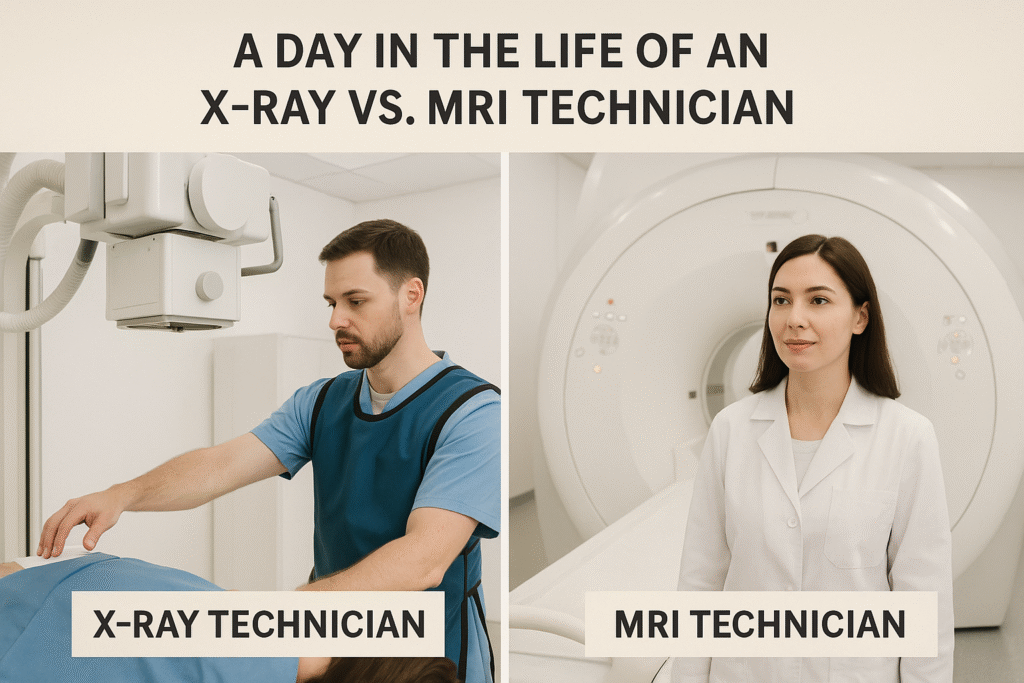A Day in the Life of an X‑Ray vs. MRI Technician: What Really Happens Behind the Scenes?

When most people visit a diagnostic center, the experience is quick — step into a room, lie still for a few minutes, and wait for the results. But behind that smooth process are highly trained professionals making it all happen: X-ray and MRI technicians.
While both roles revolve around diagnostic imaging, their daily routines, skill sets, and equipment vary in fascinating ways. If you’re considering a career in healthcare, this inside look might help you choose the right path — especially if you’re weighing x ray technician course fees, duration, and long-term growth.
Morning Briefings: Where It All Starts
🩻 X-Ray Technician
The day typically starts with reviewing the schedule — from chest X-rays to emergency trauma cases. Since X-ray imaging is often the first diagnostic step for doctors, the technician must be ready for quick turnarounds.
They check the calibration of the X-ray machine, wear their radiation protection gear, and prep the examination room. Accuracy is key, but speed matters just as much — especially in busy hospitals or trauma centers.
🧲 MRI Technician
For MRI technicians, mornings are more about planning. Since MRIs take longer and require more patient prep (removing metal, explaining the machine, checking for implants), technicians often begin with longer consultations.
They also perform safety checks on powerful magnetic fields, calibrate coils, and verify that all images meet the radiologist’s standards.
Midday: Peak Hours, Unique Challenges
X-Ray Techs Are on Their Feet
By mid-morning, X-ray techs are in full swing — handling everything from orthopedic imaging to dental scans or even assisting in operation theatres with C-arm imaging.
It’s not just about pressing buttons. A good technician has to position patients correctly, reassure nervous individuals, and often capture images within seconds, especially in emergency cases.
“One of the biggest misconceptions is that X-rays are simple,” says Aniket, a senior technician in Mumbai. “Sometimes we need over 50 images a day. And every patient’s case is different.”
MRI Techs: Deep Focus Required
MRI procedures can last 30 to 90 minutes. The technician must maintain laser-sharp focus, monitoring patients through intercoms and watching real-time scans.
Noise, claustrophobia, or anxiety in patients is common. It’s the MRI tech’s job to create a calm environment, explain the procedure clearly, and ensure the images are precise — because there are no quick re-dos.
Patient Interaction: A Soft Skill That Matters
While both techs work with machines, their human interaction differs.
X-ray techs may see dozens of patients a day — sometimes only for 5–10 minutes.
MRI techs spend more time with each patient, especially those with health concerns, mobility issues, or psychological anxiety.
Empathy, patience, and the ability to explain complex processes in simple terms are crucial — especially in India, where patients may not speak the same language or fully understand the scan.
Skill Sets & Career Paths
Both roles demand strong technical knowledge, anatomy understanding, and machine handling. But…
X-ray technicians typically start working earlier — within 12–18 months of training.
MRI technicians often pursue additional specialization after foundational radiography training, given the complexity of MRI equipment.
The choice depends on your interest — fast-paced, high-volume work (X-ray) or deep-dive diagnostic imaging (MRI).
What About the Course Fees?
If you’re planning to get into this field, one of the practical questions is: “What are the x ray technician course fees?”
While fees vary based on location and college reputation, at institutions like Scope College in Maharashtra, you can expect:
X-ray Technician Course Fees: ₹50,000 to ₹80,000 annually for a diploma.
MRI Technician Specialization: Often pursued after a radiology diploma, with separate certifications costing ₹30,000–₹70,000 depending on course structure and duration.
Keep in mind, these investments pay off quickly — with growing demand in hospitals, diagnostics labs, and even international placements.
Final Thoughts: Which Path Should You Choose?
There’s no “better” between the two — only what suits your personality, strengths, and career goals.
Want fast-paced action, flexibility, and an early career start? Go for X-ray.
Prefer depth, high precision, and working on advanced machines? MRI might be for you.
Both careers offer stability, respect, and purpose — you’re helping diagnose and heal people every single day.
